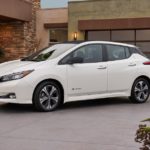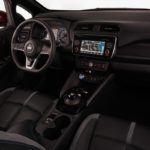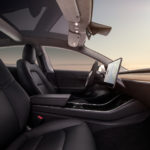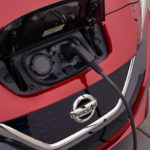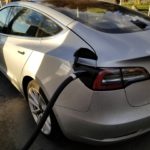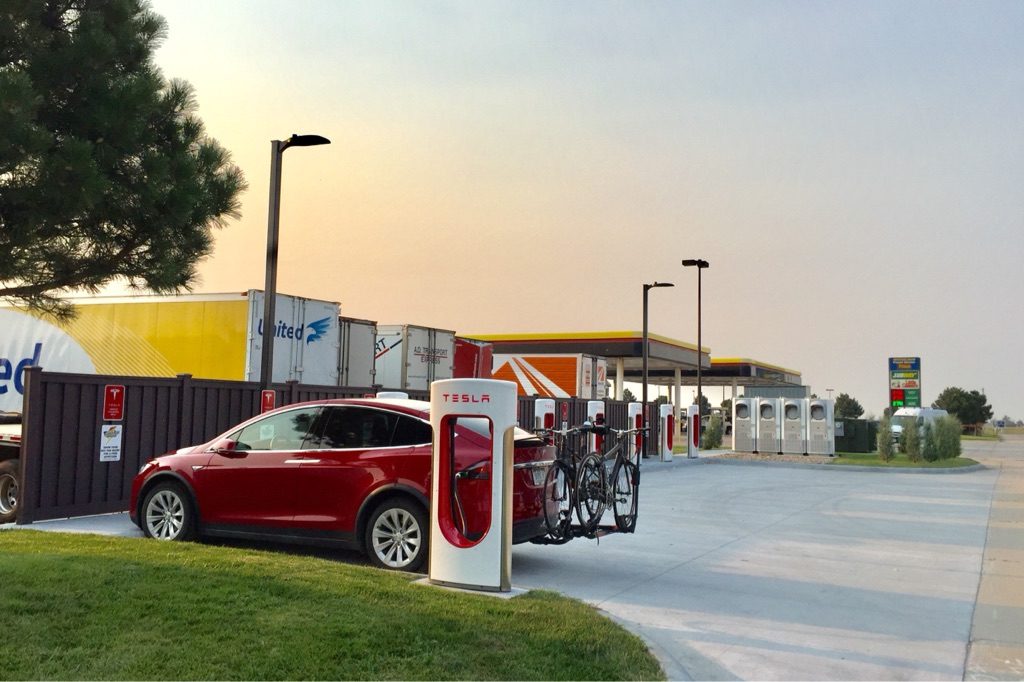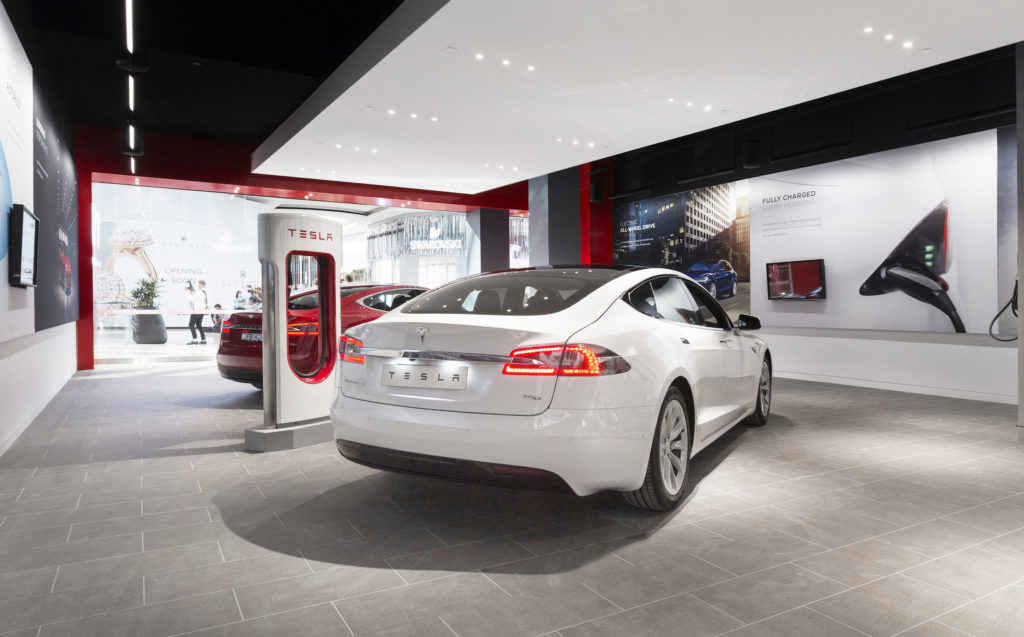
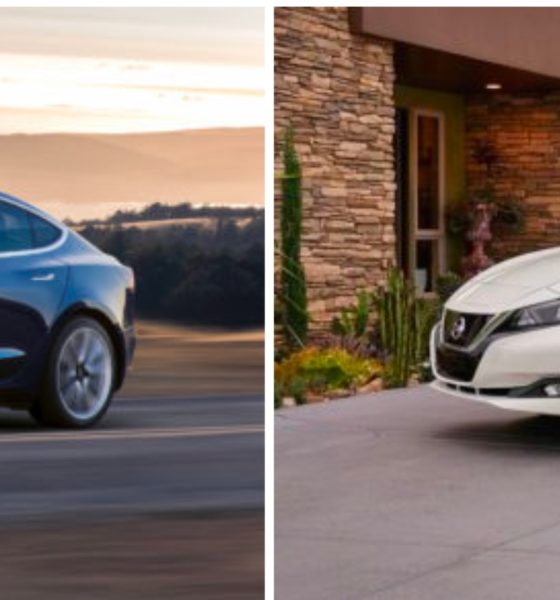
News
Tesla Model 3 vs 2018 Nissan Leaf – A side by side comparison
Tesla’s mission is simple and includes getting other automakers to join in the party. The Chevy Bolt, quirky as it may look, technically beat Tesla to market with a 200+ mile range EV that can be had for the $35,000 ballpark. Nissan, who I humbly believe to be the only other automaker currently taking full EVs seriously, has just announced their all new 2018 Leaf. The party is undoubtedly slow, but other automakers such as Volvo have at least talked about “electrification” (clever marketing shorthand for hybrids) but we can no longer deny that electric vehicles are here and their growth will not be able to be stopped.
Just as every concept EV talked about before 2016 was touted as a “Tesla killer,” it is now impossible not to compare every new electric offering with the much anticipated Tesla Model 3. So let’s do just that. The table below highlights some key specs for each.
| NISSAN LEAF | TESLA MODEL 3 | |
| Base price, before tax credits | $29,990 | $35,000 |
| Price with options | SL – $36,200 | Premium + EAP – $45,000 |
| Range (miles) | 150 (higher coming 2019) | 220 (310 for $9,000 upgrade) |
| Battery | 40 kWh/ (higher coming 2019) | Undisclosed |
| Charge time – Level 2 | Up to 22 miles per hour | Up to 30 miles per hour (std batt) |
| Charge time – Level 3 | Up to 88 miles per ½ hour | Up to 130 miles per ½ hour (std) |
| Charging network | No dedicated network | Tesla Supercharger, pay per use |
| Overall Length/Width | 176.4” / 70.5” | 184.8” / 82.2” |
| Cargo space | 23.6 cf | 15 cf |
| Body style | 4-door hatchback | 4-door sedan |
| Infotainment | Apple CarPlay, Android Auto | Tesla’s own |
| Main display | 7” | 15” |
| 0-60 mph time | 8 seconds (Motor Trend est.) | 5.6 seconds |
| Driver’s Assist Suite | ProPILOT ($2,200) | Autopilot ($5,000) |
| Automatic Emergency Braking | Standard | Standard |
If you want to get into a relatively long range EV (150 miles or greater) for the lowest possible price, the base 2018 Nissan Leaf wins out. I will also assume that you will be able to get your hands on a Leaf much sooner than a Model 3. Finally, if you absolutely insist on a hatchback, the Leaf has it.
Outside of those three things, and possibly the still large size of a Model 3, I can’t personally find any reason to choose a Leaf over a Model 3. To be clear I’m proud of Nissan for upping their game a bit. The 2018 version is in my very humble opinion, far superior in the looks department to the frog-like 2017 it is replacing. Nissan’s V-Motion grille is sharp, and hopefully takes your attention off the obvious charge port cover above it. The lines of the car itself are much more closely aligned with Nissan’s other offerings, which I find to have adequate design. Similarly, the rear tail lights are modern and edgy. If you can excuse all the buttons, the interior looks sharp. The Apple and Android faithful alike will appreciate the available car play integration. The bottom line for me is that every EV is a step in the right direction, even if this car won’t compel families to ditch the gasoline completely. In the absence of a reliable and dedicated fast charging network for long distance travel, the Leaf is still primarily a commuter car. 150 miles of range will simply allow a few after work activities without much thought.
I am excited to see the range and price that Nissan makes available in 2019 because for now, the base cost per mile of $199.93 falls far short of Tesla’s $159.09. I’d also like to see them re-think their battery management system, which I am to understand leaves something to be desired. One owner described his experience with a 2014 Leaf as losing 20% capacity thus far.
When looking at what we know about the Model 3 however, I can’t really compare the Leaf in any serious manner. I’m trying to be reasonable, to give Nissan a fair shake, but there are several things that make me a Tesla fanatic that are sorely missing from the Leaf – and any other current EV for that matter – that may or may not ever come close.
Supercharging. EVs will remain a commuter or secondary car until you can load up the kids and head to Disney with the reasonable assurance that there are plenty of chargers along the way that will a) be working, and b) charge quickly. Tesla has made a huge commitment in this front because they know that’s what it takes.
Over the air updates. I have not yet heard of Nissan taking this approach, but I suspect if they do, it would be limited to maps and small changes. I don’t foresee the Leaf being able to give your car the sudden ability to automatically open your garage four years after you’ve purchased it. Some current automakers do have software updates for their vehicles, but my understanding is that you have to bring it in to the dealership to have it done. This totally defeats the purpose.
Dealerships. You’d be hard pressed to find a harsher critic of dealerships than I. Whether discussing the 2011 Jeep Wrangler that took me 3 hours to get for the exact price I walked in and demanded, or that time I spoke on behalf of a recently widowed neighbor with an actual cash budget who could not, no matter how you pitch it, afford that extended dealer’s warranty package, I can go on and on and about how much I dislike the experience. It always takes hours. You always get passed around from salesperson to manager to finance person. You may even get your credit run 10 times simultaneously (I’m talking to you, Hyundai dealership!) No thank you. I will order my car online, know the exact price and meet you there with a pre-printed check for the exact amount owed.
Looks. I get it, I really do, people love hatchbacks. My Model S is a hatch and has accommodated many a Home Depot trip. My once beloved Scion tC was a hatch, and once hauled 27 boxes of Pergo brand laminate floor planks. Even the Jeep with the horrible dealership experience picked up a washing machine. A washing machine! But I simply cannot wrap my head around the idea that you could conceivably compare the gorgeous, timeless and sleek looks of the Model 3 with the quirky, if a bit modern and sharp, Nissan Leaf.
Performance. There’s a reason I never considered a hybrid or EV before. Now that I’m a bit older and have the budget to pick a car I actually like, I’m not going to voluntarily drive something that takes 8 seconds to get to 60. I want tight steering, good handling, and the ability to make my passengers squeal with delight when I punch it.
Interior. This is a personal preference and I’m with you if you think the minimalistic interior of the Model 3 is crazy. It is. But I can just about promise you that you will not miss all those buttons. I sat in a Porsche Macan at the auto show and while I expected to feel great inside a new offering from a brand with as much clout as Porsche, I was too busy wondering what in the world all those buttons did. It’s almost a joke how many.
Confession: I started this post excited about the new Leaf. I tweeted about it first thing this morning; the more the merrier in EV world if you ask me. But when getting right down to the specifications, it’s hard not to see that everyone else still has a long way to go. They’re taking baby steps while Tesla is competing in the long jump.
What do you think? Do the two cars compare? Tell us in the comments!

Elon Musk
Starlink passes 9 million active customers just weeks after hitting 8 million
The milestone highlights the accelerating growth of Starlink, which has now been adding over 20,000 new users per day.

SpaceX’s Starlink satellite internet service has continued its rapid global expansion, surpassing 9 million active customers just weeks after crossing the 8 million mark.
The milestone highlights the accelerating growth of Starlink, which has now been adding over 20,000 new users per day.
9 million customers
In a post on X, SpaceX stated that Starlink now serves over 9 million active users across 155 countries, territories, and markets. The company reached 8 million customers in early November, meaning it added roughly 1 million subscribers in under seven weeks, or about 21,275 new users on average per day.
“Starlink is connecting more than 9M active customers with high-speed internet across 155 countries, territories, and many other markets,” Starlink wrote in a post on its official X account. SpaceX President Gwynne Shotwell also celebrated the milestone on X. “A huge thank you to all of our customers and congrats to the Starlink team for such an incredible product,” she wrote.
That growth rate reflects both rising demand for broadband in underserved regions and Starlink’s expanding satellite constellation, which now includes more than 9,000 low-Earth-orbit satellites designed to deliver high-speed, low-latency internet worldwide.
Starlink’s momentum
Starlink’s momentum has been building up. SpaceX reported 4.6 million Starlink customers in December 2024, followed by 7 million by August 2025, and 8 million customers in November. Independent data also suggests Starlink usage is rising sharply, with Cloudflare reporting that global web traffic from Starlink users more than doubled in 2025, as noted in an Insider report.
Starlink’s momentum is increasingly tied to SpaceX’s broader financial outlook. Elon Musk has said the satellite network is “by far” the company’s largest revenue driver, and reports suggest SpaceX may be positioning itself for an initial public offering as soon as next year, with valuations estimated as high as $1.5 trillion. Musk has also suggested in the past that Starlink could have its own IPO in the future.
News
NVIDIA Director of Robotics: Tesla FSD v14 is the first AI to pass the “Physical Turing Test”
After testing FSD v14, Fan stated that his experience with FSD felt magical at first, but it soon started to feel like a routine.

NVIDIA Director of Robotics Jim Fan has praised Tesla’s Full Self-Driving (Supervised) v14 as the first AI to pass what he described as a “Physical Turing Test.”
After testing FSD v14, Fan stated that his experience with FSD felt magical at first, but it soon started to feel like a routine. And just like smartphones today, removing it now would “actively hurt.”
Jim Fan’s hands-on FSD v14 impressions
Fan, a leading researcher in embodied AI who is currently solving Physical AI at NVIDIA and spearheading the company’s Project GR00T initiative, noted that he actually was late to the Tesla game. He was, however, one of the first to try out FSD v14.
“I was very late to own a Tesla but among the earliest to try out FSD v14. It’s perhaps the first time I experience an AI that passes the Physical Turing Test: after a long day at work, you press a button, lay back, and couldn’t tell if a neural net or a human drove you home,” Fan wrote in a post on X.
Fan added: “Despite knowing exactly how robot learning works, I still find it magical watching the steering wheel turn by itself. First it feels surreal, next it becomes routine. Then, like the smartphone, taking it away actively hurts. This is how humanity gets rewired and glued to god-like technologies.”
The Physical Turing Test
The original Turing Test was conceived by Alan Turing in 1950, and it was aimed at determining if a machine could exhibit behavior that is equivalent to or indistinguishable from a human. By focusing on text-based conversations, the original Turing Test set a high bar for natural language processing and machine learning.
This test has been passed by today’s large language models. However, the capability to converse in a humanlike manner is a completely different challenge from performing real-world problem-solving or physical interactions. Thus, Fan introduced the Physical Turing Test, which challenges AI systems to demonstrate intelligence through physical actions.
Based on Fan’s comments, Tesla has demonstrated these intelligent physical actions with FSD v14. Elon Musk agreed with the NVIDIA executive, stating in a post on X that with FSD v14, “you can sense the sentience maturing.” Musk also praised Tesla AI, calling it the best “real-world AI” today.
News
Tesla AI team burns the Christmas midnight oil by releasing FSD v14.2.2.1
The update was released just a day after FSD v14.2.2 started rolling out to customers.

Tesla is burning the midnight oil this Christmas, with the Tesla AI team quietly rolling out Full Self-Driving (Supervised) v14.2.2.1 just a day after FSD v14.2.2 started rolling out to customers.
Tesla owner shares insights on FSD v14.2.2.1
Longtime Tesla owner and FSD tester @BLKMDL3 shared some insights following several drives with FSD v14.2.2.1 in rainy Los Angeles conditions with standing water and faded lane lines. He reported zero steering hesitation or stutter, confident lane changes, and maneuvers executed with precision that evoked the performance of Tesla’s driverless Robotaxis in Austin.
Parking performance impressed, with most spots nailed perfectly, including tight, sharp turns, in single attempts without shaky steering. One minor offset happened only due to another vehicle that was parked over the line, which FSD accommodated by a few extra inches. In rain that typically erases road markings, FSD visualized lanes and turn lines better than humans, positioning itself flawlessly when entering new streets as well.
“Took it up a dark, wet, and twisty canyon road up and down the hill tonight and it went very well as to be expected. Stayed centered in the lane, kept speed well and gives a confidence inspiring steering feel where it handles these curvy roads better than the majority of human drivers,” the Tesla owner wrote in a post on X.
Tesla’s FSD v14.2.2 update
Just a day before FSD v14.2.2.1’s release, Tesla rolled out FSD v14.2.2, which was focused on smoother real-world performance, better obstacle awareness, and precise end-of-trip routing. According to the update’s release notes, FSD v14.2.2 upgrades the vision encoder neural network with higher resolution features, enhancing detection of emergency vehicles, road obstacles, and human gestures.
New Arrival Options also allowed users to select preferred drop-off styles, such as Parking Lot, Street, Driveway, Parking Garage, or Curbside, with the navigation pin automatically adjusting to the ideal spot. Other refinements include pulling over for emergency vehicles, real-time vision-based detours for blocked roads, improved gate and debris handling, and Speed Profiles for customized driving styles.
